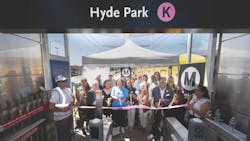L.A. K Line’s Hyde Park Station dedicated to Crenshaw community and nearby neighborhoods
Los Angeles County Metropolitan Transportation Authority (L.A. Metro) officials were joined by elected officials, community leaders, supporters and residents to dedicate the new Hyde Park K Line Station in South Los Angeles.
The K Line, also referred to as the Crenshaw/LAX Transit Project, is officially expected to open later this year, bringing new rail service to one of the city’s oldest communities.
The Hyde Park Station is located between the intersections of Crenshaw Boulevard and Slauson Avenue and 59th Street in the Hyde Park community. The station serves one of the most densely populated areas along the Crenshaw Corridor and Los Angeles, giving residents and others a new transportation option to the automobile.
The Hyde Park Station is surrounded by several historic neighborhoods such as Leimert Park, Vermont Square, Manchester Square and Inglewood. The station is a short walk from Crenshaw High School and several local mom-and-pop businesses.
“Hyde Park is one of the oldest neighborhoods in the entire city of Los Angeles, so it’s fitting that Metro will soon be offering a new transit alternative to this important community,” said Glendale City Council Member and L.A. Metro Board Chair Ara J. Najarian. “I am excited to see the opportunities this new station and line will bring to Hyde Park by connecting people to local parks, schools, housing and other key destinations.”
Several housing developments by private developers are now underway in the area that will also benefit from the new station.
L.A. Metro is also supporting improved safety for pedestrians to access the new station. With funding through L.A. Metro’s transit-oriented development planning grant, the city of Los Angeles has completed a Crenshaw Boulevard Streetscape Plan that will enhance safety by improving the walking environment through the installation of wider sidewalks and crosswalks and curb extensions and median refuge islands, making it easier for L.A. Metro riders to access the Hyde Park Station, whether they are walking, riding a bike, scooter or skateboard as part of their trip.
Hyde Park is one of eight new stations to the 8.5-mile K Line. Additional stations are Expo/Crenshaw, Martin Luther King Jr., Leimert Park, Fairview Heights, Downtown Inglewood, Westchester/Veterans and Aviation/Century.
The $2-billion K Line will open with seven stations later this year. The Aviation/Century Station is projected to open in fall 2023. The Airport Metro Connector Project, which will provide a connection to Los Angeles International Airport, is scheduled to open in late 2024. The line will connect the existing Metro E Line (Expo) at Crenshaw and Exposition Boulevards to the C Line (Green) in El Segundo, providing a key transit alternative to driving the increasingly congested 10, 405 and 105 freeways.
L.A. Metro’s station dedication ceremony also celebrated the importance of the station, its art and nearby historic neighborhoods. Public officials recognized and featured early project champions, small businesses, local performing artists and the Hyde Park Station commemorative pin contest winner, high school student Allysa Enriquez.
All K Line stations include artwork commissioned through the agency’s Metro Art program. Artists were selected through an open, competitive selection process following the recommendation of a panel of community-based arts professionals. The Hyde Park Station includes a series of porcelain enamel artworks by Carlson Hatton, titled Hyde Park Oasis.
“Once opened, the Hyde Park station will be an important node for our transit service in south L.A.,” said Stephanie N. Wiggins, CEO, L.A. Metro. “As we dedicate this station today, I want to thank all the community members who helped Metro design, build and deliver a piece of community infrastructure that will be well-used and well-loved for generations.”
